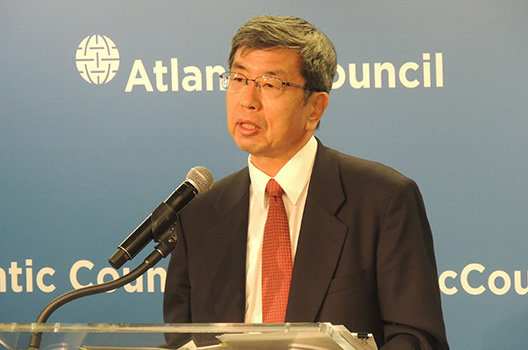 On October 6, the Brent Scowcroft Center on International Security hosted President Takehiko Nakao of the Asian Development Bank (ADB) to discuss Asia’s economic outlook, the role of the ADB in Asia, and its relations with China and the Asian Infrastructure Investment Bank (AIIB). Mr. Nakao was introduced by the President and CEO of the Atlantic Council Frederick Kempe and the subsequent discussion with the audience was moderated by Olin Wethington, nonresident senior fellow at the Atlantic Council’s Brent Scowcroft Center on International Security.
On October 6, the Brent Scowcroft Center on International Security hosted President Takehiko Nakao of the Asian Development Bank (ADB) to discuss Asia’s economic outlook, the role of the ADB in Asia, and its relations with China and the Asian Infrastructure Investment Bank (AIIB). Mr. Nakao was introduced by the President and CEO of the Atlantic Council Frederick Kempe and the subsequent discussion with the audience was moderated by Olin Wethington, nonresident senior fellow at the Atlantic Council’s Brent Scowcroft Center on International Security.
Speaking about Asia’s economic outlook, President Nakao stated that the new lower interest rate environment for Asia might become a new normal, but savings rates continue to increase due to the growth of pensions. Economic growth in Asia continues to be resilient, despite declining performance in China. In particular, economic growth in India is strong–in the seven to eight percent range. He highlighted strong performances in Malaysia, Vietnam, Philippines, Bangladesh, and the opening of Myanmar. China has ceased to be able to sustain ten percent growth rates, but more attention is given to consumption, environmental issues, and the service sector. Concerns remain as to how quickly China can restructure legacy industries, such as steel and construction materials, and whether China can contain its rapid explosion of credit.
President Nakao elaborated on the ADB’s growing importance and growth in membership over the last few decades. He noted that China was still an important recipient despite calls in the US Congress to ‘graduate’ China, and noted that the lending carries with it incentives for China to adhere to environmental standards. He noted that the ADB does not lend to China on a concessional basis. Furthermore, the ADB has increased its capital base by 50 percent by combining its concessional Asian Development Fund portfolio and the Ordinary Capital Resources of the bank.
The AIIB and ADB both support energy and infrastructure development, but President Nakao noted that the ADB also has a role in education, vocational training, and poverty alleviation. He emphasized that the AIIB is not a competitor but rather a partner in collaboration with the ADB. He cited that infrastructure needs in Asia which are estimated to be around 800 billion USD annually. He highlighted differences in attitude towards governance and residence missions. The ADB would cooperate with the Silk Road initiative but at the same time not become an arm of the Chinese initiative.
